At a Glance: Golden Week
Previous photo used: ” Carp streamer in Sagamihara ” by suneko licensed under the Creative Commons Attribution-Share Alike 2.0 Generic license. (CC BY-SA 2.0) No changes or modifications made. Wikimedia Commons Link
As April comes to a close, Japan gears up for the annual event known as Golden Week. But what is Golden Week exactly?
Typically running from April 29th to May 5th or 6th, Golden Week or ゴールデンウィーク is a string of consecutive holidays. Golden “Week” is something of a misnomer, as the days add up to less than a full week and in some cases are even broken up (such as this year, where the proper GW days are 4/29 and 5/3-5/6). However, it is not uncommon for some to take additional days off to make it more or less a full week.
The name ‘Golden Week’ dates back to 1948. Following the passing of the National Holiday Laws, a number of holidays fell at the end of April/start of may. Many leisure-based industries experienced revenue spikes at this time, including the film industry. After one of their films experienced a higher-than-ever box office during this time of year, the managing director of Daiei Film Co., Ltd. dubbed it “Golden Week” based on the Japanese radio lingo “golden time”, the period with the highest listener ratings.
The holidays that make up Golden Week are:
April 29th – Shōwa Day (昭和の日, Shōwa no Hi)
May 3rd – Constitution Memorial Day (憲法記念日, Kenpō Kinenbi)
May 4th – Greenery Day (みどりの日, Midori no Hi)
May 5th – Children’s Day (子供の日, Kodomo no Hi)
And there you have it. A short introduction to Golden Week. We here at MUSUBI will be celebrating Golden Week from tomorrow, and will be taking next Tuesday off. Come back on Friday 5/7 for another article about health, food and life in Japan. Until then, Happy Golden Week!
Ready to experience your own adventures throughout Japan? Numerous opportunities are still available! For more information, read all about the job of an ALT!
Photo Credits:
Previous photo used: ” Carp streamer in Sagamihara ” by suneko licensed under the Creative Commons Attribution-Share Alike 2.0 Generic license. (CC BY-SA 2.0) No changes or modifications made. Wikimedia Commons Link
All other content (text) created by the original author and © 2021 MUSUBI by Borderlink
Top photo: Kanenori on Pixabay
Are you looking for places where you can admire the natural beauty of Japan? Somewhere where you can enjoy peace and calm? There are still many destinations in Japan that can offer us adventure and natural beauty without heavy tourist crowds. If you are looking for a holiday where you can immerse yourself in nature, these destinations are perfect.
Sumatakyo (Sumata Gorge), Shizuoka Prefecture
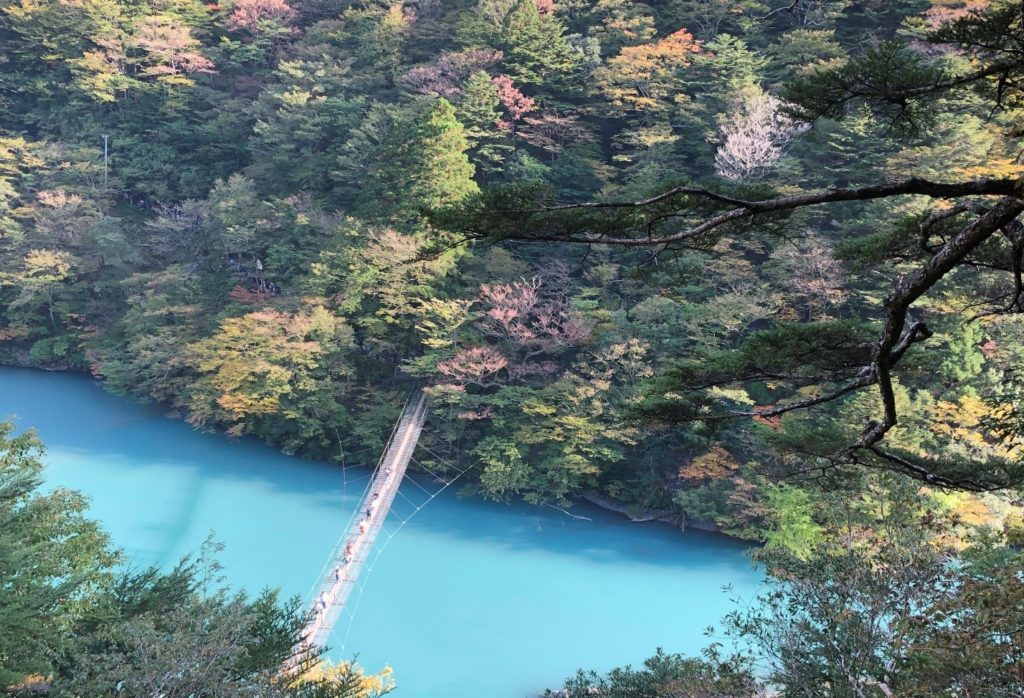
Enjoy the scenic view of a suspended bridge over the emerald green lake. Yume no Tsuribashi or Dream Suspension Bridge is located in Sumata Gorge, Shizuoka Prefecture. The bridge is 90 meters long and suspended 8 meters above a dam lake. From Sumatakyo hot spring, which is the starting point of this course to the suspension bridge is about 40 minutes walk. You will surely be pleased by this lake that appears when you are a little tired of hiking. You can enjoy the beautiful emerald green lake while enjoying both the thrill of the oscillating bridge and the seasonal view of the mountains. Only 10 people can cross this bridge at a time.
Oze National Park, Gunma Prefecture
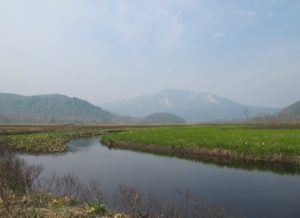 Oze National Park is situated in the central area of Japan’s main island of Honshu, around 150 kilometers north of Tokyo. Eruptions of the Oze volcanoes have shaped the terrain over thousands of years. Along the way, they created a string of peaks from Mount Aizu-Komagatake in the north to Mount Shibutsu and Mount Kasagatake in the south. Mount Tashiro, Mount Taishaku and Mount Daikuratakayama are to the west.
Oze National Park is situated in the central area of Japan’s main island of Honshu, around 150 kilometers north of Tokyo. Eruptions of the Oze volcanoes have shaped the terrain over thousands of years. Along the way, they created a string of peaks from Mount Aizu-Komagatake in the north to Mount Shibutsu and Mount Kasagatake in the south. Mount Tashiro, Mount Taishaku and Mount Daikuratakayama are to the west.
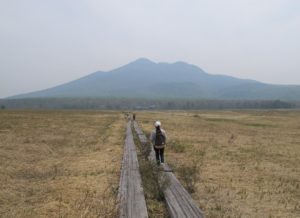 An extinct volcano, Mount Hiuchigatake, is at the center of the park and is also the tallest peak of the region. It overlooks Lake Ozenuma and Ozegahara Marsh.
An extinct volcano, Mount Hiuchigatake, is at the center of the park and is also the tallest peak of the region. It overlooks Lake Ozenuma and Ozegahara Marsh.
It is a beautiful place for hiking. You can take a lot of good pictures and enjoy the nature. You can enjoy the beautiful scenery, fresh mountain air and well-preserved nature. While enjoying the flowers and scenery you can spend an elegant time leisurely hiking in Oze.
Magome and Tsumago, Gifu & Nagano Prefecture
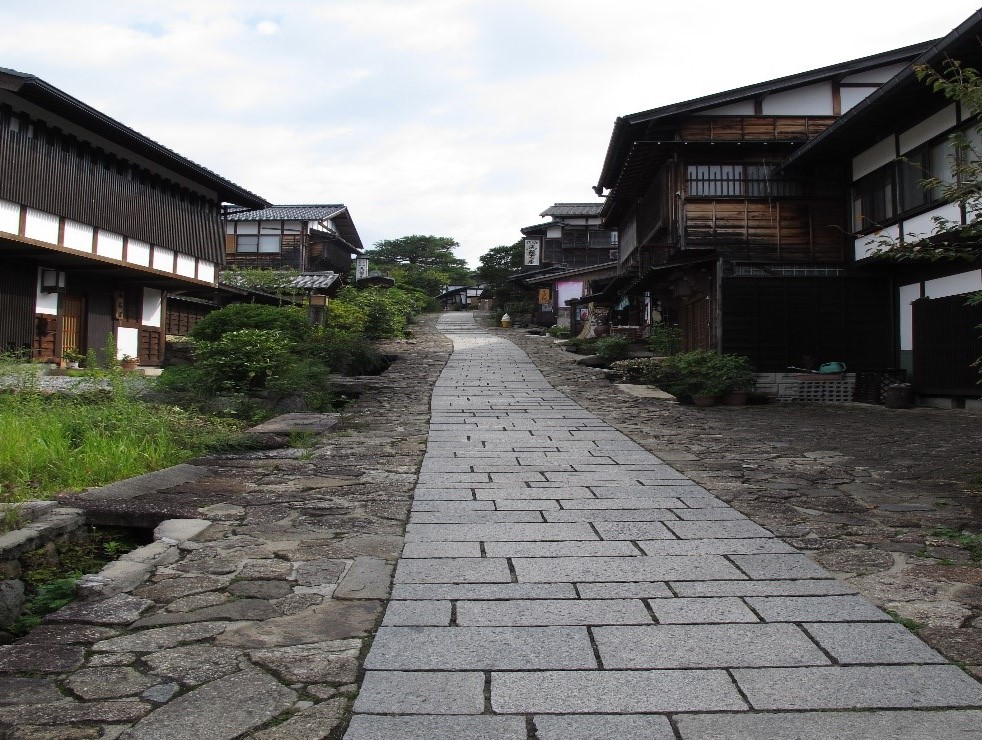
Magome and Tsumago are two beautifully preserved traditional villages. Both are located in Kiso Valley in Gifu Prefecture (Magome) and Nagano Prefecture (Tsumago). You can enjoy the natural beauty and historical sites.
You can get a cedar wood certificate proving that you hiked between the two post towns. It is an interesting place to visit with beautiful and well-preserved houses built during Edo period.
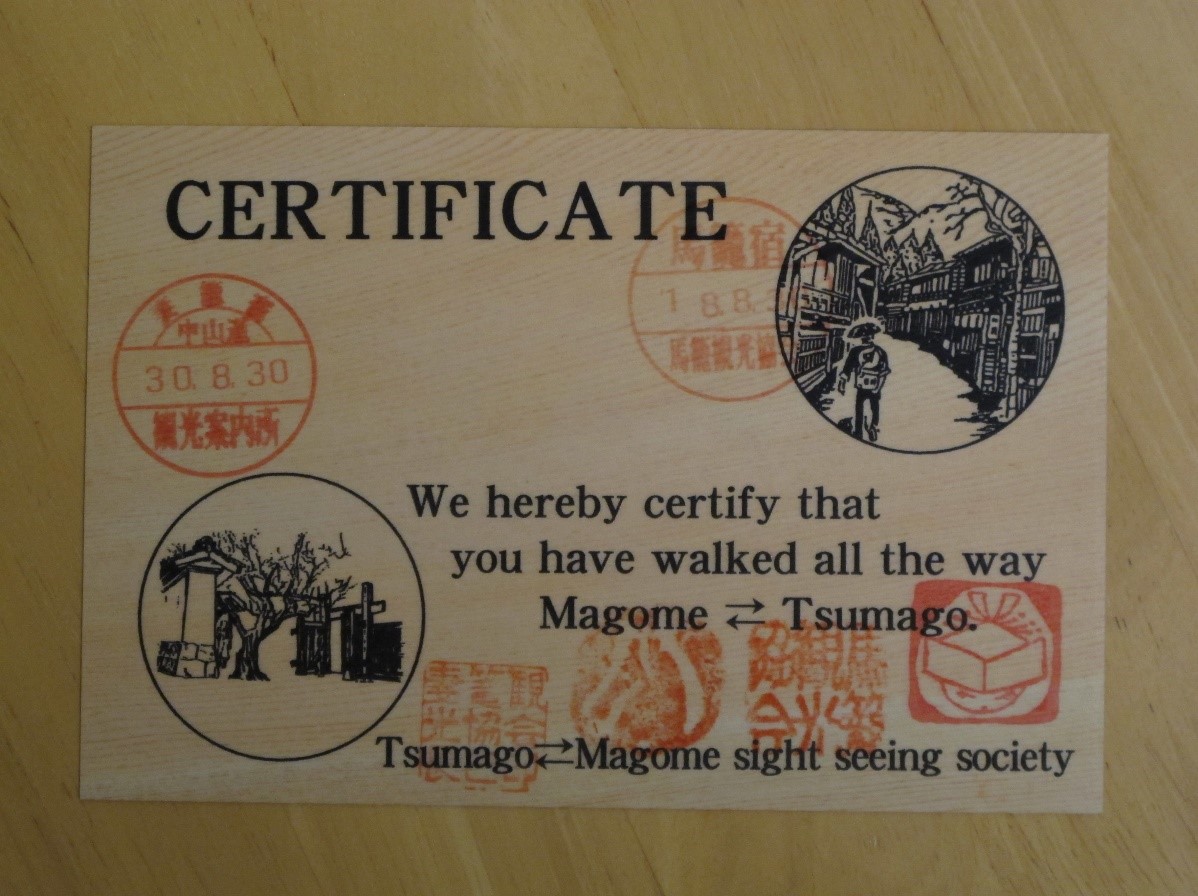
Lake Okutadami, Niigata Prefecture
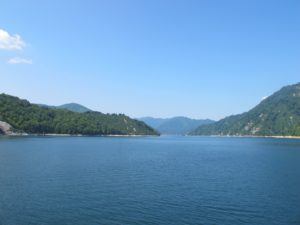 Lake Okutadami is a man-made lake formed by the construction of the Okutadami dam. You can take a ride on a tour boat and enjoy the beautiful view. You can also enjoy a variety of different cruises on small ferries for a better glimpse of the beauty of the surroundings.
Lake Okutadami is a man-made lake formed by the construction of the Okutadami dam. You can take a ride on a tour boat and enjoy the beautiful view. You can also enjoy a variety of different cruises on small ferries for a better glimpse of the beauty of the surroundings.
I hope these inspire you for your next travel adventure!
Ready to experience your own adventures throughout Japan? For more information, read all about the job of an ALT!
Photo Credits:
Top photo: Kanenori on Pixabay
Additional photos were provided by the original author, used with permission
All other content (text) created by the original author and © 2021 MUSUBI by Borderlink
Top Photo: taken by MUSUBI staff member, Ⓒ 2021 MUSUBI by Borderlink
The situation we have found ourselves to be in over the last year and a half (and for the foreseeable future) has left many in an anxious limbo. A pandemic is a terrifying thing, made even more so for those living in a foreign country. Keeping our health is the most important thing to focus on these days. For many who come from western countries like America, there is little as hard to adjust to with regards to our health than the use of masks.
Let’s get one thing straight: the mask is essential. Not just in Japan, but around the world right now. You should be wearing a mask every day. A medical one if you can, or at least one or two decent cloth masks every time you go outside. They’re our third best defense against this virus after getting a vaccine and social distancing.
In Japanese society, before the pandemic, you may have seen people in your office or around town wearing a mask. Seeing the casual use of them may have been a shock for many their first time in the country. If you catch a cold or get a sniffle, or even have allergies and went to a clinic, you may have been given some medicine and told to wear a mask for a while.
Here’s why: the mask is for the people around you. People wore the masks before Covid-19 not for themselves, but for the people around them. The mask isn’t for you, it’s for every single person you see around you when you go outside. Japanese society is very group-centric, and the health of the group, of society, should come first.
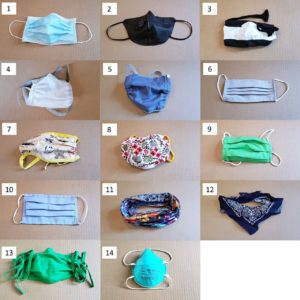
(Listed from most to least effective against transmission https://www.health.com/condition/infectious-diseases/coronavirus/most-effective-face-mask)
“But it’s so stuffy! It’s itchy! I can’t see with my glasses!” I hear you say. Yeah, they’re not the most comfortable thing out there. But you’re responsible for finding a style that fits with your needs, to do your part. Right now, there are a lot of options:
1. Fitted N95 mask with no exhalation valve (#14)
2. Three-layer surgical mask (#1)
3. Cotton-polypropylene-cotton mask (#5)
4. Two-layer polypropylene apron mask (#4)
5. Swath of polypropylene mask material (not shown)
6. Two-layer pleated cotton mask (#13)
7. Two-layer pleated cotton mask (#7)
8. N95 mask with exhalation valve (#2)
9. Two-layer “Olson style” cotton mask (#8)
10. One-layer Maxima AT (air textured) mask (#6)
11. One-layer pleated cotton mask (#10)
12. Two-layer pleated cotton mask (#9)
13. Knitted mask (#3)
14. Double-layer bandana (#12)
15. Gaiter-type neck fleece (#11)
So many choices! Of course some are better than others, and we should be sure to leave the more effective PPP tools for the medical professionals that truly need them, but there’s nothing stopping us normal folk from finding something that works. And there are so many awesome designs out there now!
My point is that the mask isn’t just for you. In the east, especially, the mask is an important, culturally ingrained tool for the greater good. If you are one of those people that thinks that you’re not in danger from the current situation, that’s not the smartest thing to think but it is much more likely for you to be asymptomatic. But that nice little obaasan going grocery shopping for the week, who lives alone and can’t go and see her friends? She is very much at risk for much more serious complications.
So please, wear your mask and keep your sniffles and coughs at a distance, for the obaasan.
Photo Credits:
Top Photo: taken by MUSUBI staff member, Ⓒ 2021 MUSUBI by Borderlink
Additional Photo by Health.com
All other content (text) created by the original author and © 2021 MUSUBI by Borderlink
Top photo: Dave Adamson on Unsplash
Are you living in Japan? Do you like American football? If you’re interested in a home-away-from-home event, then the Tomodachi Bowl is perfect for those who love the game as well as those who are simply homesick.
The Tomodachi Bowl is played yearly in Japan on one of the many American military bases. The event consists of American high school students from the bases in Tokyo and their counterparts from Japanese high schools in Kanagawa Prefecture.
The Tomodachi Bowl has its roots in an event called the Global Challenge Bowl, which was played in March 2008 and 2009 at Kawasaki Stadium. It featured Japanese U-19 collegiate players against high school-aged players from 10 states. Japan won both games.
Originally called the the Camellia Bowl, the game’s name was changed after the 2011 Tohoku earthquake and tsunami disaster. The Tomodachi Bowl commemorates the partnership between the U.S. and Japanese militaries during Operation Tomodachi, the effort to help put the Tohoku region back on its feet in the wake of the terrible tragedy.
Although it tends to be a somewhat lopsided event, with Team USA being unbeaten in games played on U.S. bases, it’s all in the spirit of fun, and a great event for families. Many Japanese high school students as well as college players feel it’s an honor and a litmus test for them to go up against Americans.
As Coach David Stant, Team Rising Sun of Hawaii said, “it may be the first and last time for them to play somebody from America, to see where they rank against those from the country that invented the game.
Ultimately, the Tomodachi Bowl is about having fun and stands as a symbol of the everlasting friendship between Japan and the US. It’s also a great event to watch, with edge-of-your-seat excitement and, for some, a nostalgic taste of home.
Photo Credits:
Top photo: Dave Adamson on Unsplash
The author wishes to extend thanks to Dave Ornauer (Stars and Stripes, 2016) for information used in this article.
All other content (text) created by the original author and © 2021 MUSUBI by Borderlink
Top photo: Photo by Luke Paris on Unsplash
Vacation travel in Japan is quite different from that in the US. One difference is the length of the trips. In the US, week-long vacation trips are common. In Japan, one or two nights seems to be the norm. But, if you choose your destination wisely and plan well, you can see and do so much in that short time.
Although I have only lived in Japan since last year, my wife is Japanese and I have been visiting Japan since 2001. I have been to a number of big cities like Tokyo, Osaka, Kyoto, and Nagoya. I have also visited places beyond the big cities, such as Kamakura, Takayama, and Hakone. I found these trips to be much more memorable.
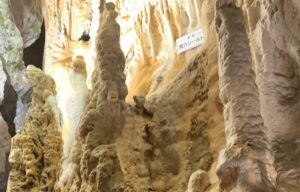
The Great Limestone Cave of Hida
If you choose places beyond the big cities, you can see much more of your destination because they will likely not be so spread out. While you won’t have these places to yourself, they will not be as crowded as the big cities and can provide a more relaxing experience, allowing you to pay more attention to the details of the area.
Over the abbreviated summer vacation this past year, my family took a short trip to the Hida region of Gifu prefecture, spending one night in Takayama.
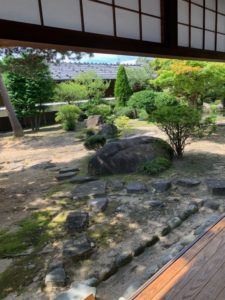
The garden in the Takayama Jingū
We left early in the morning and arrived at the Great Limestone Cave of Hida late in the morning. We toured the caverns and went through the museum. We then headed to Takayama, arriving there in time for a late lunch, followed by shopping, a little sightseeing, and a soak in the hotel’s rooftop outside bath.
After a nice dinner, which included a sampling of delicious Hida beef, we took an evening walking tour of Takayama, getting a much less crowded look at the old city, before bathing again and turning in.
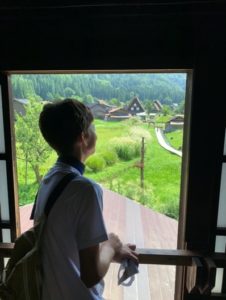
Looking out over Shirakawa-go from one of the gasshō-zukuri
In the morning, another bath and breakfast was followed by more shopping and sightseeing, including visiting the Takayama Jinya, a national historic site.
We left Takayama in mid-morning and headed to Shirakawa-Go, a world heritage site not very far away. We enjoyed a lunch of hand made soba and toured the gasshō-zukuri (steeply pitched, thatched roof houses). Finally, later in the afternoon, we headed home.
By choosing a smaller, less central destination, we completed our trip tired, but not exhausted, and reveling in the memories we had made.
Photo Credits:
Top photo: Luke Paris on Unsplash
Previously cited photo: Aaron Shumaker on flickr
Additional photos provided by Photos by Kiemi Langlois, used with permission
All other content (text) created by the original author and © 2021 MUSUBI by Borderlink

In front of Sensō-ji (Photo by Conner Dooley)
Japan has sometimes been called the “the land of gods”. Indeed, the Shinto
faith is centered around the belief that supernatural beings inhabit all
things. There are many shrines and temples dotting the landscape of
Japan. They come in many sizes depending on what is being worshipped
there. Some have even been regarded as cultural properties and UNESCO
World Heritage Sites. Visiting them has become a personal hobby of mine,
and hopefully you can gain an appreciation of them as I have.
First of all, a common word you may hear is kami. What are they? They
are deities or spirits that can represent certain ideas like love, birth, war,
death, etc. or actual objects in nature like a tree, volcano, lake, and so on.
It is possible for even dead humans to be venerated as kami, being
regarded as ancestral or protector figures. With the introduction of
Buddhism to ancient Japan, aspects of the religion became merged with
Shinto, making it not uncommon for a Shinto shrine and Buddhist temple to
occupy the same space.
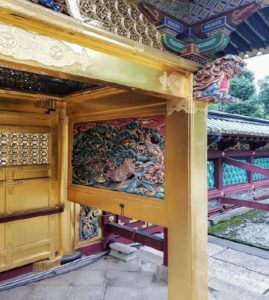
Inside Ueno Tōshō-gū (Photo by Conner Dooley)
Some of the most famous temples and shrines boast the most fascinating architecture and intricate carvings. The colors used are vibrant and appealing. I have found myself standing in marvel at the craftsmanship involved in the creation of such buildings. I believe that the pictures don’t do them justice and must be experienced in person. If you are a history buff, some of these structures have been at the center of disasters, conflicts, and major changes that have happened to Japan over the centuries. Luckily, most major sites will have an English translation of a pamphlet given out that goes into the details of the shrine or temple.
There are also fun things that you can do and buy at shrines and temples. First of all, you have to offer a small prayer and money to the deity of the shrine or the Buddha of the temple. There are specific rituals for them that can be found online by doing a little research, but I won’t go into detail here. The money you offer is up to you but the traditional amount is five yen. Think of it as a donation for the upkeep of the buildings and being able to preserve history for future generations.
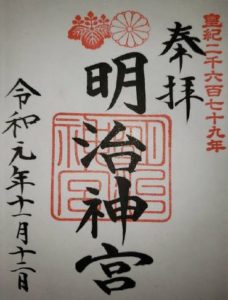
Nikko Tōshō-gū goshuin (Photo by Conner Dooley)
Next, each shrine and temple is different, but you may be able to visit a museum or walk around the gardens. Finally, you can find out your fortune or buy an omamori, to protect you from bad experiences and receive specific blessings. If you want, you can also buy a goshuinchō, or a book to keep goshuin. The goshuin are unique stamps that are purchased from temples and shrines to show that you have visited there. If you can get a lot of goshuin, it turns the goshuinchō into an impressive work of art that shows where you’ve been.
Temples and shrines are a place of worship and history. They offer an insight into the traditions and culture of Japan. I have many stories from the temples and shrines, as well as goshuin, from the places I have visited. I can’t wait for the end of the pandemic so that I have the opportunity to
travel and visit much more in Japan!
Ready to experience your own adventures throughout Japan? Numerous opportunities are still available! For more information, read all about the job of an ALT!
Photo Credits:
Additional photos provided by Conner Dooley, used with permission
All other content (text) created by the original author and © 2021 MUSUBI by Borderlink
Top Photo: drawsandcooks on Pixabay
Of all the problems you may encounter moving to Japan, finding something to eat will never be one of them, at least if you’re adventurous and not allergic to fish. Even so, with a little effort, you can find plenty of food to suit even a Western palate. And, plenty of local, traditional meals that don’t include seafood.
That said, if you can include seafood, I heartily recommend you do so. Japan is a sushi lover’s paradise, of course, and where in the United States you might be thankful to get a lousy tuna roll for ten bucks, in Japan the same money will get you a veritable feast of fish, egg, seaweed, and squid artfully prepared.
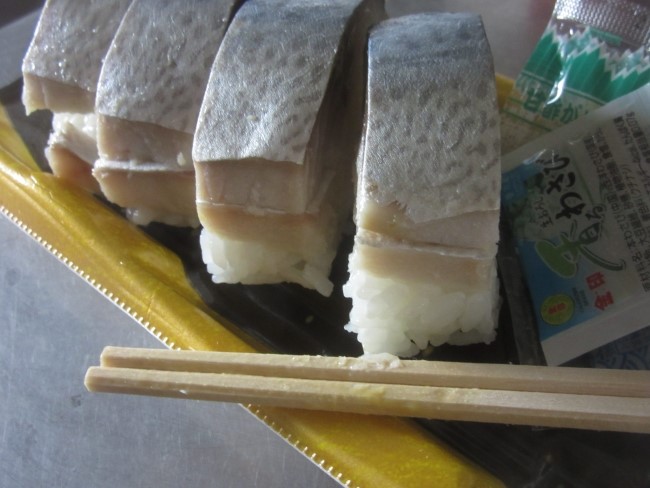
In a city like Osaka, where I first stayed, it’s hard to take ten steps without bumping into great food. There seems to be at least twenty restaurants for every building and a dozen more between. I found I could reliably duck into any little spot at random and get a great and completely unique meal, usually for no more than 700 yen. Whether it’s a noodle dish like udon, soba, or ramen or curry, sushi, sashimi, or soup, the food is amazing. And in or around Osaka, you’d be remiss if you didn’t sample the okonomiyaki.
Usually made with pork belly or squid, the batter for this savory pancake has grated yam and cabbage. The finished okonomiyaki is often topped with mayonnaise and is very filling and very tasty. You’ll find the Japanese have a great love for Western style pancakes, too, though they’re often a little fluffier. I’ve even seen sushi wrapped in a pancake!
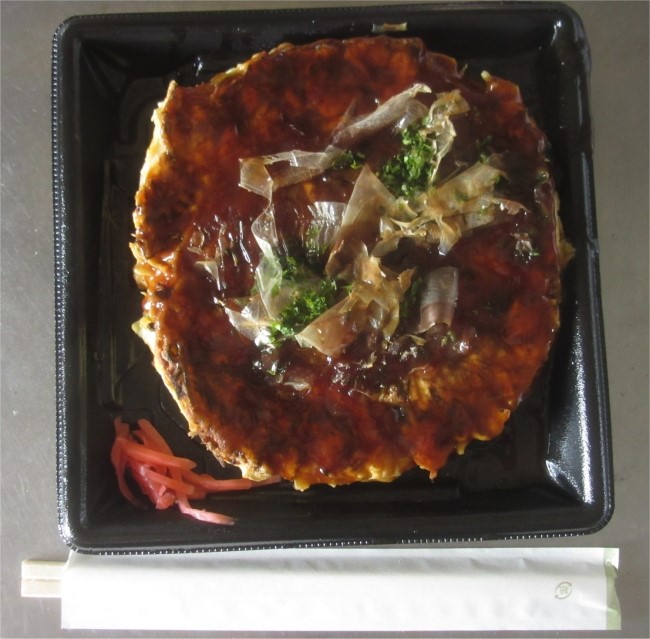
Maybe you don’t want to go to a restaurant, though. As with most things, the conbini, or convenience store, has you covered. At 7/11, Family Mart, or Lawson you can find an array of prepared meals a cut well above what you’ll find in the equivalent American store. Even so, conbini meals are generally inferior, and more expensive, to what you’ll find in a supermarket like A-Coop or Okuwa.
But as always, the cheapest option is to cook yourself. An indispensable kitchen gadget in Japan is the rice cooker. Coming in a variety of sizes and varying widely in price, some rice cookers even have compartments for steaming vegetables and a variety of other bells and whistles.
If you’re hankering for meals like back home, one thing you can do is go ahead and make it like you did back home. You can find most of the same essential ingredients in Japan, usually without being able to read any Japanese. Most products are packaged the same way and it’s easy to infer from context whether something is dish soap or laundry detergent. However, for cooking, there are a few kanji characters that are very helpful to know. Often these things are in packages that offer few other indicators of what they contain.
小麦粉 Komugiko (Flour)
酢 Su (Vinegar)
油 Abura (Cooking oil)
There are many ways to enjoy the culinary paradise called Japan. Whether it’s in restaurants, supermarkets, or your own kitchen, hopefully with these tools you’ll find the experience a little easier. Don’t be afraid to try something new. In my experience, odds are you’ll find something good.
Photo Credits:
Top Photo: drawsandcooks on Pixabay
Additional photos were provided by Adam Marshal, used with permission.
All other content (text) created by the original author and © 2021 MUSUBI by Borderlink
Top photo: t_watanabe on Pixabay

I went from “Is this how it feels to be sucked into a wormhole?” to “This is what heaven must look like in a utopian point of view”.
On November 1, 2019, Shibuya Scramble Square opened its doors to the Tokyo public and it immediately caught media attention — not for its famous location overlooking the Shibuya scramble crossing or the Hachiko statue — nor for its triumph in holding the title of being the tallest building in Shibuya, but for its top floor; the observation deck on floor 47.
“360 degree panoramic view” — that’s what made this building famous, but that isn’t the only thing that made the media buzz— it was the experience of being there altogether. First, you will need to purchase your ticket in the waiting area on the 14th floor. In here you will have a pleasant time observing the Shibuya crossing and admire the various commercial facilities surrounding the building.
Offline tickets generally costs 2,000 yen per person but pro-tip, purchase your tickets online and you’ll only need to pay 1,800 yen per head and save yourself the stress of waiting in long lines. The tickets are timed, so arrive to the waiting area 5-10 minutes before your ticket admission and you’ll be good to go.
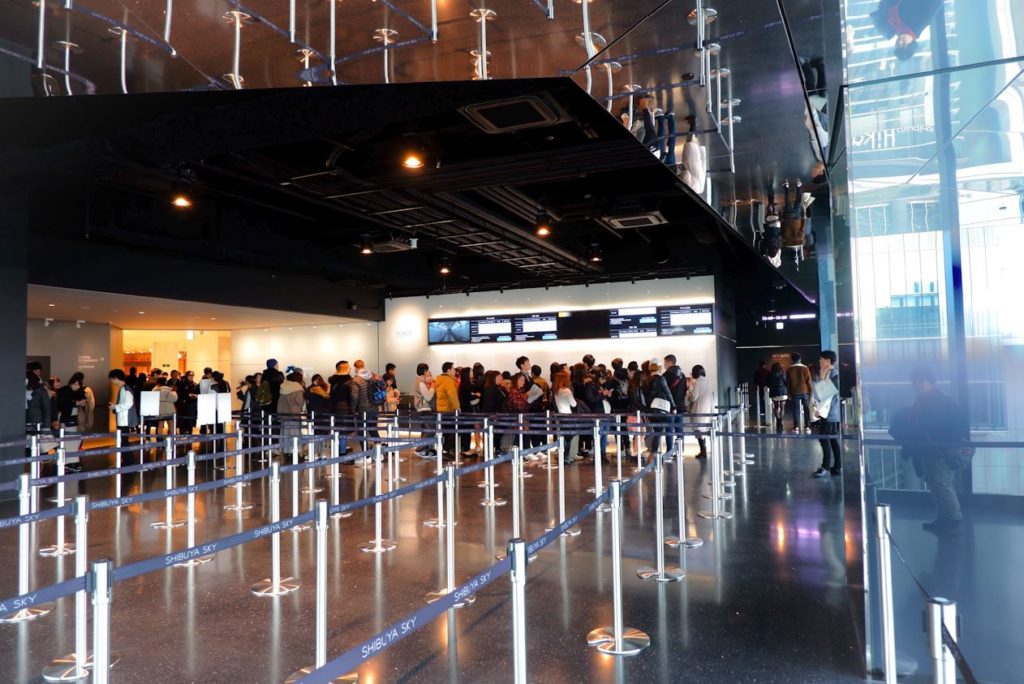
Next you will be guided to the “Sensing Hall”; a hallway that will remind you of Star Wars because of its laser lights and the pitch black walls. Then you will be asked to enter the “Transition Pod” which is a huge elevator with ceiling effects that makes you feel like you’ve accidentally entered a black hole.
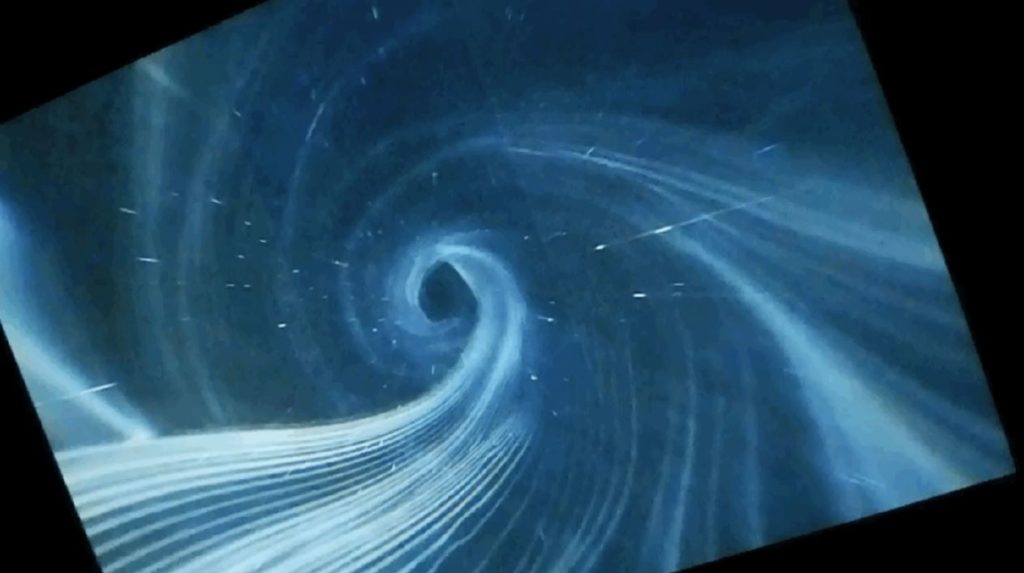
After a few minutes of a funny feeling in your stomach and a ringing in your ears you will then arrive to the “Leading Line” on the 47th floor; a wide hallway that leads to the observation deck. It’s very bright in here which is such a contrast to all the pitch black walls on your way up — it somehow gives you a sense of relief. From here you will be asked to leave your valuables which may easily get carried away by the wind such as your hat, umbrella, bag or scarf. Most people we went with just brought their phones and cameras with them.
You will find four different spots inside the Observation deck namely: Crossing Light, Geo Compass, Cloud Hammock and Sky Edge. Each area has its own experience to offer. The Crossing Light is a long space filled with sofas facing outward where up to 6 people can sit at the same time. The Cloud Hammock is popular among kids and young adults while the Sky Edge is the most favorable space to take a photo for your social media feed.
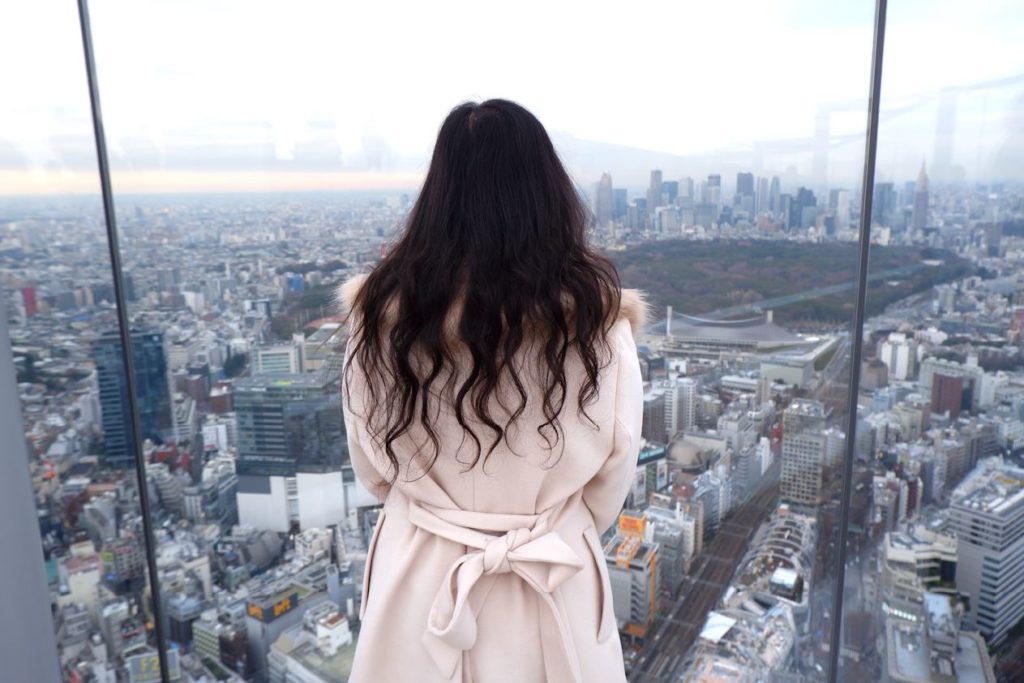
Don’t forget to purchase your tickets from their official website: www.shibuya scramblesquare.com. The easiest access is from right above Shibuya Station; opening and closing times are from 9:00 A.M. until 11 P.M. with the final admission time being 10:00 in the evening.
Is it worth the buck? A thousand percent yes, I’ve even visited it twice since. It is that great of an experience whether, you are a sci-if lover or not. It makes you experience suspension of disbelief in real life — a feeling I’ve only felt while watching the Ballet or attending an Opera. Freedom of the mind and body in moderation is a beautiful concept, but sometimes totally letting go of reality for the sake of experience is exquisitely breathtaking.
Ready to experience this and other treasures in Japan? For more information, read all about the job of an ALT!
Photo Credits:
Top photo: t_watanabe on Pixabay
All additional images were provided by Zygel Doll Jamelano (used with permission)
An extended version of this article can be found on Zeefinity
All other content (text) created by the original author and © 2021 MUSUBI by Borderlink
